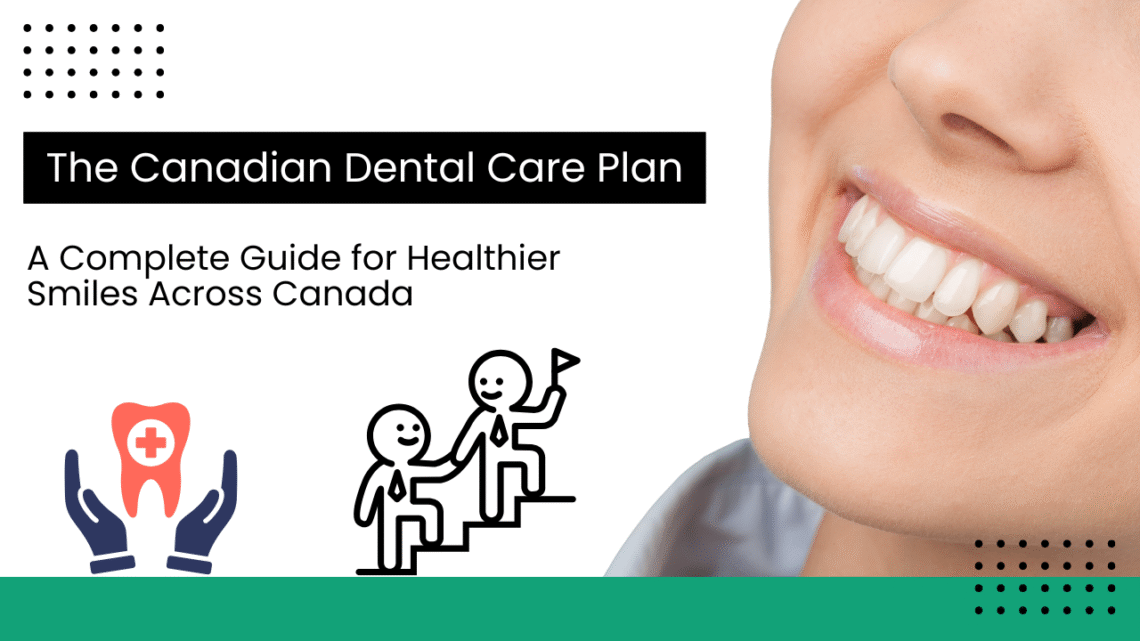Oral health is essential to overall well-being. Yet, for many Canadians, the cost of dental care has long been a barrier to getting necessary treatment. Cavities, gum disease, and other oral health issues often go untreated, leading to pain, infection, and broader health concerns. The Canadian Dental Care Plan (CDCP), introduced by the federal government, aims to change that by making dental care more accessible and affordable for millions of Canadians.
In this comprehensive guide, we’ll explore everything you need to know about the Canadian Dental Care Plan (CDCP)—a groundbreaking initiative aimed at making dental services more accessible and affordable for millions of Canadians.
Whether you’re a senior, a parent, a person with a disability, or simply someone without private dental insurance, this plan could offer vital support for your oral health needs. We’ll break down who qualifies, what dental treatments are covered, how to apply, and how to get the most out of the Canadian Dental Care Plan benefits. As the program continues to roll out across the country, understanding its details can help you take full advantage of the services available to you and your family. From preventive care to more complex treatments, the CDCP is designed to close the gap in access and affordability. This guide aims to deliver clear, useful information to help you navigate the plan with confidence.
🦷 What is the Canadian Dental Care Plan (CDCP)?

The Canadian Dental Care Plan is a federal government initiative launched to improve access to dental care for eligible Canadians who do not have private dental insurance. This plan aims to reduce financial barriers and prevent serious oral health problems by covering a wide range of dental services at low or no cost.
The Canadian Dental Care Plan (CDCP) is a major federal healthcare initiative launched to improve access to dental services for Canadians who do not have private dental insurance. Rolled out in carefully planned phases, the CDCP specifically targets vulnerable groups who are most likely to face financial and accessibility barriers to oral health care. These groups include seniors, children under 18, people with disabilities, and low- to moderate-income families. By focusing on these key demographics, the Canadian Dental Care Plan aims to ensure that those who need dental care the most are prioritized.
The plan was developed in response to growing public concern over the lack of dental coverage in Canada’s universal healthcare system. For many years, oral health was excluded from basic health benefits, despite its direct connection to overall well-being. Poor dental health has been linked to numerous chronic conditions, including diabetes, cardiovascular disease, and respiratory infections. The CDCP is a bold step toward bridging that gap.
Once fully implemented, the Canadian Dental Care Plan is projected to cover up to 9 million Canadians, offering essential services such as cleanings, exams, X-rays, fillings, and extractions. It represents not just a health policy, but a shift in how Canadians view oral health as a fundamental part of total health. The program is expected to reduce emergency room visits related to dental issues and improve the quality of life for millions. As more providers enroll and awareness grows, the CDCP will continue evolving into a cornerstone of Canada’s public health system.
.
📅 Timeline of Implementation
- December 2023: Applications opened for seniors aged 87 and above.
- January 2024–June 2024: Gradual expansion to seniors aged 65+, children under 18, and adults with a disability tax credit.
- By 2025: Full rollout for all eligible Canadians who meet income and insurance criteria.
✅ Eligibility Criteria for the Canadian Dental Care Plan
To qualify for the CDCP, individuals must meet all of the following requirements:
- No Private Dental Insurance
Applicants must not have access to any private dental insurance plan. - Adjusted Family Net Income Below $90,000
The CDCP is income-based. Benefits decrease on a sliding scale as income increases. - Canadian Resident for Tax Purposes
You must be a resident of Canada and have filed a recent tax return. - Eligibility for Public Health Insurance
You must be eligible for your province or territory’s public health insurance.
Tip: Ensure your income tax is filed annually, as it directly affects your eligibility.
💡 Top 8 Tips to Make the Most of the Canadian Dental Care Plan
1. Understand Your Coverage Level
The CDCP uses a sliding scale model based on your adjusted family net income:
- Income below $70,000: 100% coverage
- Income between $70,000–$79,999: 60% coverage
- Income between $80,000–$89,999: 40% coverage
- Income above $90,000: Not eligible
💡 Tip: Review your Notice of Assessment (NOA) from the CRA to check your income level before applying.
2. Apply Early and Track Deadlines

Since the Canadian Dental Care Plan (CDCP) is being rolled out in carefully scheduled phases, it’s essential to stay informed about when you or your family members become eligible to apply. Eligibility timelines vary depending on factors such as age, income level, and specific health benefits like the Disability Tax Credit. Failing to apply during your designated application period could result in delays or a temporary loss of access to vital dental care services.
To avoid missing out, regularly check the official Government of Canada website for updates on rollout schedules and requirements. The earlier you apply once you’re eligible, the sooner you can start receiving coverage for checkups, cleanings, fillings, and other essential dental treatments. The Canadian Dental Care Plan is a valuable opportunity for those without private insurance to maintain better oral health. Staying proactive ensures you won’t miss your chance to benefit from this national initiative aimed at making dental care more accessible.
💡 Tip: Sign up for email updates from the Government of Canada or visit the official CDCP website regularly.
3. Choose Participating Dentists
Under the Canadian Dental Care Plan (CDCP), only dentists and dental professionals who have officially agreed to participate in the program and bill the government directly are authorized to provide covered services. This means that not every dental clinic or provider will automatically accept CDCP patients. Before scheduling any dental appointment, it’s crucial to confirm whether your chosen dentist is registered with the Canadian Dental Care Plan.
Doing so ensures that your visit will be eligible for coverage, and you won’t face unexpected out-of-pocket expenses. Participating providers will submit claims directly to the CDCP on your behalf, simplifying the process and reducing financial stress. As the program expands, more dental professionals are expected to join. However, always call ahead or check with your provider to avoid confusion. Being informed and proactive helps you get the most out of your Canadian Dental Care Plan benefits and ensures a smooth dental care experience.
💡 Tip: Call your local dental office and ask, “Do you participate in the Canadian Dental Care Plan?”
4. Know What Services Are Covered
As of now, the CDCP includes coverage for:
- Cleanings and checkups
- X-rays
- Fillings
- Extractions
- Root canals
- Dentures
- Oral surgery
- Some preventive and restorative treatments
💡 Tip: Not all services may be fully covered; confirm details beforehand to avoid surprise fees.
5. Prepare Necessary Documents
When applying, ensure you have:
- Your Social Insurance Number (SIN)
- Proof of income (latest tax filing)
- Details of your public health insurance
💡 Tip: Seniors may be automatically enrolled if they receive OAS/GIS benefits, but others must apply through the portal or by phone.
6. Combine with Provincial Programs
Several provinces in Canada already offer dental support programs, such as the Ontario Seniors Dental Care Program and the Alberta Adult Health Benefit. The Canadian Dental Care Plan (CDCP) is designed to complement these existing provincial and territorial programs—not replace or conflict with them. This means eligible individuals can benefit from both federal and provincial dental coverage, helping to fill any gaps and reduce out-of-pocket expenses. For example, if a provincial program covers basic services but excludes certain treatments, the CDCP may step in to provide additional support.
It’s important to understand how your provincial benefits align with the Canadian Dental Care Plan so you can maximize your dental coverage. Be sure to inform your dental provider about all the plans you are enrolled in, so they can help coordinate your care and billing. By combining resources, Canadians can receive more comprehensive and affordable dental treatment through this collaborative approach.
💡 Tip: If your province already covers some services, the CDCP may fill in the gaps.
7. Keep Good Dental Hygiene Habits
While the Canadian Dental Care Plan (CDCP) provides vital financial support for dental services, prevention remains the most effective way to protect your oral health and minimize long-term costs. Even with coverage, daily habits play a crucial role in avoiding serious dental issues. Brushing your teeth twice a day with fluoride toothpaste, flossing regularly, and reducing your intake of sugary foods and drinks can significantly lower your risk of cavities, gum disease, and other oral problems.
These simple practices help maintain a healthy mouth and reduce the need for more complex—and often costly—treatments, even if they are covered under the Canadian Dental Care Plan. Good oral hygiene also contributes to better overall health, including heart and digestive health. Remember, the CDCP is there to support your dental needs, but it’s your daily routine that builds a strong foundation for lifelong oral wellness. Prevention and coverage together offer the best protection..
💡 Tip: Use your CDCP coverage for preventive checkups to catch issues early.
8. Reapply and Update Information Annually
Your eligibility for the Canadian Dental Care Plan (CDCP) is not permanent and may change from year to year, depending on factors such as your household income, tax status, or access to private dental insurance. It’s essential to stay informed and regularly review your eligibility status to ensure continued access to benefits under the Canadian Dental Care Plan. Life changes—like a new job, retirement, or changes in your family structure—can impact your qualification.
In some cases, you may need to reapply annually or provide updated financial information to maintain your coverage. Failing to do so could result in losing access to important dental care services. To avoid interruptions, check the government’s official CDCP website or consult with Service Canada for the latest updates and reapplication requirements. Staying proactive ensures that you and your family continue to benefit from the comprehensive support offered by the Canadian Dental Care Plan year after year..
💡 Tip: Set a reminder to check your eligibility status annually after tax season.
🦷 What the Canadian Dental Care Plan Covers
The CDCP is designed to cover a broad range of dental services. While exact coverage may vary depending on your income and specific needs, here’s a breakdown:
| Service Type | Examples | Covered? |
| Preventive Care | Cleanings, exams, fluoride treatments | ✔️ |
| Diagnostic Services | X-rays, oral exams | ✔️ |
| Restorative Services | Fillings, crowns, root canals | ✔️ Partial |
| Prosthodontics | Dentures (full or partial) | ✔️ Partial |
| Oral Surgery | Tooth extractions, minor surgery | ✔️ |
| Endodontic Services | Root canals, pulp treatments | ✔️ Partial |
Note: Cosmetic procedures such as teeth whitening, veneers, and orthodontics are not covered under the CDCP.
🚫 Limitations of the Canadian Dental Care Plan
While the CDCP is a huge step forward, it’s important to be aware of its current limitations:

- Cosmetic Dentistry Not Covered
- Not All Dentists Are Participating Yet
- Partial Coverage for Higher-Income Brackets
- May Not Include Emergency Procedures Outside Network
- May Require Copay Depending on Income
💡 Advice: Always confirm your coverage before undergoing treatment.
🧾 How to Apply for the Canadian Dental Care Plan
Step 1: Check Eligibility
Visit Canada.ca to check if you’re eligible.
Step 2: Gather Documents
You’ll need your SIN, income details, and provincial health card.
Step 3: Apply Online or by Phone
- Online: Through the official CDCP portal
- Phone: 1-833-537-4342
Step 4: Wait for Confirmation
Once approved, you’ll receive a welcome package and coverage details.
💡 Tip: You don’t need to print a dental card. Your provider will verify your eligibility through the CDCP system.
👨👩👧 Who Will Benefit the Most from the CDCP?
The plan is especially beneficial for:
- Seniors: Many live on fixed incomes and skip dental visits due to cost.
- Low-Income Families: Children will now receive consistent dental care.
- People with Disabilities: Many have higher oral health risks and fewer resources.
- Rural Communities: Where access to affordable care is limited.
💬 Public Reactions and Expert Opinions
The Canadian Dental Association (CDA) has praised the initiative, saying it addresses long-standing oral health inequities. However, they also emphasize the need for collaboration with provincial dental bodies and careful management to avoid clinic overload and delays.

The introduction of the Canadian Dental Care Plan (CDCP) has brought a sense of relief and renewed hope to millions of Canadians, especially seniors and low-income families who have long struggled to afford proper dental care. For years, many individuals postponed or skipped essential dental treatments such as cleanings, fillings, or extractions simply because the costs were too high and private insurance was out of reach. Parents have shared stories of sacrificing their own dental needs to prioritize care for their children, while seniors on fixed incomes often delayed critical procedures due to budget limitations.
With the Canadian Dental Care Plan, this burden is starting to lift. Families now feel empowered to seek preventative care, knowing they can access support without financial strain. Seniors have expressed gratitude for the opportunity to maintain their oral health and overall well-being without the worry of unaffordable bills. The CDCP is more than just a health program—it’s a lifeline that’s restoring dignity and quality of life to those who previously felt forgotten by the healthcare system. As the plan continues to roll out nationwide, it promises a future where access to dental care is not a privilege but a right for all Canadians, regardless ofincome
.
📈 Why the Canadian Dental Care Plan Matters
- One-third of Canadians lack dental insurance.
- 1 in 5 Canadians avoid the dentist due to cost.
- Poor oral health is linked to heart disease, diabetes, and low self-esteem.
- Prevention reduces the burden on the healthcare system and improves quality of life.
📝 Conclusion: A New Era for Oral Health in Canada
The Canadian Dental Care Plan (CDCP) is a transformative and long-overdue initiative that addresses one of the most significant gaps in Canada’s healthcare system—access to affordable dental care. For millions of Canadians, especially those without private insurance, the cost of routine dental visits has been a constant barrier to maintaining good oral health. The CDCP now offers a pathway to affordable care, bringing relief, improved health outcomes, and restored dignity to those who’ve had to delay or avoid treatment altogether.
This federal program is especially impactful for low-income families, seniors, and vulnerable populations who have been disproportionately affected by high dental costs. While the Canadian Dental Care Plan may not cover every dental procedure or provide instant solutions to every issue, it represents a major step toward universal dental coverage and health equity. The inclusion of preventative services like cleanings, exams, and X-rays, as well as basic restorative care, means fewer Canadians will suffer from untreated dental conditions.
As the CDCP continues to expand, it holds the potential to not only improve individual health outcomes but also reduce the long-term burden on the overall healthcare system. Ultimately, the Canadian Dental Care Plan is more than a policy—it’s a commitment to fairness, health, and national well-being..
By understanding how the plan works, checking your eligibility, and using the tips shared in this guide, you can take full advantage of the CDCP. Good oral health is more than just a bright smile—it’s a reflection of overall wellness. With the CDCP, Canada is moving toward a future where dental care is a right, not a luxury.





